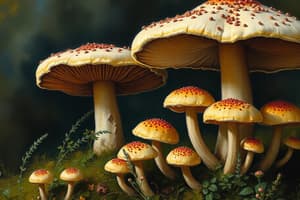Podcast
Questions and Answers
What percentage of terrestrial plant species is estimated to have mutualistic relationships with mycorrhizal fungi?
What percentage of terrestrial plant species is estimated to have mutualistic relationships with mycorrhizal fungi?
- 80% (correct)
- 60%
- 90%
- 40%
How do mycorrhizal fungi benefit from their relationship with plants?
How do mycorrhizal fungi benefit from their relationship with plants?
- By receiving sugars from their plant hosts (correct)
- By receiving nitrogen and phosphorus from the soil
- By breaking down organic matter in the soil
- By competing with other microorganisms in the soil
What is the result of mycorrhizal fungi forming deeper networks in the soil?
What is the result of mycorrhizal fungi forming deeper networks in the soil?
- An increase in soil carbon storage (correct)
- A decrease in soil carbon storage
- No significant impact on soil carbon storage
- An increase in soil nitrogen levels
What is a potential consequence of human interference, such as logging or fertilizer use, on mycorrhizal networks?
What is a potential consequence of human interference, such as logging or fertilizer use, on mycorrhizal networks?
Approximately how much more carbon can plants with mycorrhizal association transfer to soil compared to non-mycorrhizal plants?
Approximately how much more carbon can plants with mycorrhizal association transfer to soil compared to non-mycorrhizal plants?
Flashcards are hidden until you start studying
Study Notes
Forest Ecosystems and Fungi
- In forest ecosystems, nearly all plants rely on a complex network of soil organisms, including tiny bacteria, archaea, fungi, and other microscopic organisms, to lead long and healthy lives.
- Fungi play a crucial role in this ecological network, with two especially important roles: decomposers and symbiotic relationships with plants.
Decomposer Fungi
- Fungi excel at decomposing dead plant material (organic matter) due to their ability to break down tough materials found in woody plants using a wide range of enzymes.
- During decomposition, fungi release CO2 gas as a waste product, contributing to the movement of carbon from the soil into the atmosphere.
- Fungal decomposition is one of the largest global sources of carbon emissions, releasing 85 gigatonnes of carbon into the atmosphere every year.
Mycorrhizal Fungi
- Mycorrhizal fungi form mutualistic relationships with the roots of around 80% of all terrestrial plant species, providing water and nutrients in exchange for sugars.
- These relationships have been ongoing for 400 million years, since plants started to colonize land.
- Mycorrhizal fungi delve deeper into the soil, forming a significant carbon sink and keeping carbon locked away from the atmosphere.
- Plants with mycorrhizal association can transfer up to 35% more carbon to soil than non-mycorrhizal plants, and the carbon in mycorrhizal tissues may stay in the soil for many years.
Importance of Fungi in Forest Ecosystems
- Despite their critical roles, fungal diversity is often overlooked during forest management decisions.
- Human interference, such as logging or indiscriminate use of fertilizers, can alter the underground network and upset the balance of the entire ecosystem.
- Maintaining fungal diversity is essential to keep carbon stored in the soil for long periods of time and mitigate rising global temperatures.
Studying That Suits You
Use AI to generate personalized quizzes and flashcards to suit your learning preferences.




